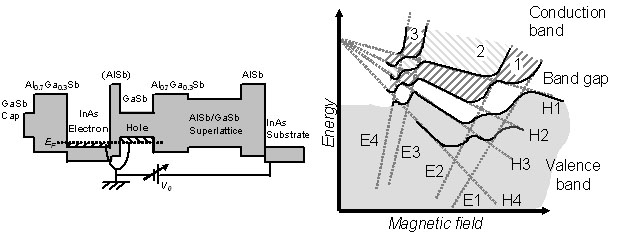InAs/GaSb electron-hole systems
Physical Science Laboratory
In InAs/GaSb heterostructures, the conduction band in InAs
and the valence band in GaSb overlap. Consequently, a two-dimensional electron
gas (2DEG) in the InAs and a two-dimensional hole gas (2DHG) in the GaSb can
coexist in close proximity. A unique quantum Hall effect (QHE) has been known
to occur in these structures where the Hall resistance is quantized by the
difference between2DEG and 2DHG Landau-level (LL) filling-factors (νe, νh).
Its mechanism had yet to be clarified, and had been thought to be a complex
combination of QHE arising in both 2DEG and 2DHG.
We clarified the mechanism using back-gated structures (Fig. 1) and detailed
magneto-transport measurements. The samples consisted of an InAs 2DEG layer
on the surface side and a GaSb 2DHG layer on the substrate side. We succeeded
in controlling the 2DHG density with the gate voltage, while keeping the 2DEG
density constant by the surface potential. Changing the thickness of the inserted
AlSb layer between the InAs and GaSb layers, which works as a potential barrier
for both 2DEG and 2DHG, the hybridization strength between 2DEG and 2DHG wavefunctions
can be controlled. Under magnetic field, in samples without wavefunction hybridization,
the electron and hole energy levels split into LLs shown as the dashed lines
in Fig. 2. In samples where wavefunction hybridization is allowed, however,
LLs also hybridize (solid lines) and a new energy structure is formed, in
which the region of νe=νh becomes effectively the band gap. Net carriers (difference
of 2DEG and 2DHG densities) fill the hybridized LLs above the band gap. Therefore,
conventional 2DEG-like QHE occurs, according to the net carrier density.
We believe our results will become useful for realizing new physics phenomena
reflecting electron-hole interactions and correlations, such as Bose-Einstein
condensation of the dipole excitons, and contribute to the development of
mid-infrared device applications using inter-subband transitions and inter-layer
tunneling.
[1] K. Suzuki et al., Phys. Rev. Lett. 93 (2004) 016803.
 |
||
|
Fig. 1. Sample potential
profile |
Fig. 2. Landau-level hybridization |
|